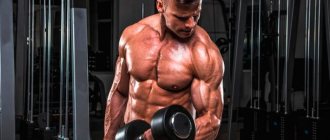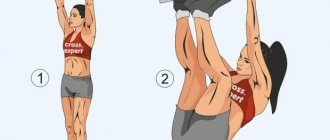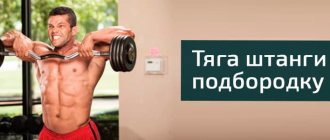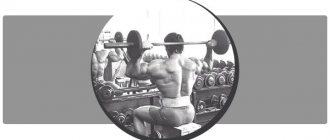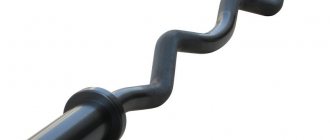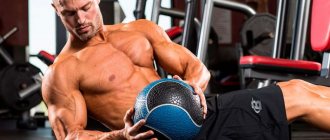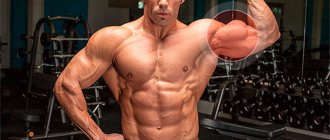Share:
What you need
- barbell
The barbell curl is a very unique exercise. With the correct technique, it is a single-joint isolating exercise. At the same time, when working with heavy weights and using the Arnold Cheating technique, it becomes multi-joint, with an evenly distributed load, which means it can even be used as a basic one.
Purpose of the exercise
Let's figure out what such an exercise as barbell curls is intended for.
Regardless of the execution technique, this exercise perfectly develops the biceps muscle of the arm. In particular, it is with its help that those very notorious “banks” can be developed.
Advantages
Its main advantages are:
- extremely simple technique;
- great variability: can be performed standing, sitting, using a Scott bench;
- the ability to work not only the biceps, but also the underlying brachialis;
- versatility: lifts are used both during the circuit and during splits;
- low risk of injury.
And, most importantly, it is suitable even for those who have only recently crossed the threshold of the hall. When combined with basic lifts, it can provide a significant increase in volume and strength.
Interesting fact: often newcomers to the gym intensively “pump the biceps”, neglecting the basic deadlifts. Because of this, the result is greatly reduced, which leads to disappointment.
Remember, growth of the biceps muscle groups is only possible with preliminary fatigue with basic exercises.
Straight bar or EZ bar
In the vast majority of cases, bench exercises are performed with an EZ bar.
The EZ bar is used to achieve maximum isolation and minimize forearm involvement.
The use of a straight bar is justified if you are lifting the barbell as a mass-building movement. In this case, the muscles of the forearm are additionally involved in the work. As a result, they actively develop along with the biceps.
True, when lifting heavy weights with a straight bar, one problem gradually arises - due to the awkward position of the hands, they begin to hurt as the exercise progresses.
Therefore, over time, most bodybuilders switch to training with an EZ barbell.
What muscles work?
Despite the apparent isolation, as in the case of pull-ups, reverse barbell curls, or more precisely, their negative phase, involve a huge number of muscles. Including:
- front deltas (act as a stabilizer);
- triceps;
- lumbar muscles (used to hold the body in an upright position);
- abdominal and core muscles (stabilization of the body is involved);
- legs (static tension in mind, increasing the person’s weight due to the projectile).
When bending the arms with a barbell with a reverse grip, the forearms are additionally used, since in this case the barbell does not rest on the palms, but is held by the strength of the fingers.
“Arnold” version
The barbell curl using the Arnold Schwarzenegger technique deserves special mention. This is a biceps curl using the back muscles and proper arching.
Execution Features
The technique for performing this version of the exercise looks like this:
- To work, take a weight that can be done 1-2 times with the correct technique. For insurance, wear a weightlifting belt.
- The projectile rises with a jerk, deflecting the body back and bringing the shoulder blades together.
- After which the barbell is slowly lowered with greater emphasis on the negative phase.
Muscles involved
Curling your arms with a barbell for biceps using the Schwartz technique radically changes the load on the muscles.
| Working group | Phase | Accenting |
| Small of the back | Body tilt back | Big. In the absence of a trained spine, it is better to use an athletic belt |
| Rhomboid back muscle | Snatch lift | Uniform. When bringing the shoulder blades together, the load is slightly lower than in front and deadlifts, but noticeable |
| Biceps brachii | All stages | During the snatch phase, by shifting the load towards the back, you can lift more weight, overcoming the strength plateau in the future. In the negative phase, with the body aligned |
| Legs | Jerk | Low. |
Pros and cons of the “Arnold” option
Is it worth using Arnold cheating in your training? After all, on the one hand, this is a very traumatic and complex exercise that requires more concentration than the classic barbell lifting technique. On the other hand, the benefit from it is not as great as it seems.
Of course, for people who have been training at the gym for less than one year, cheating will do more harm than good. But for people who are experiencing a strength plateau in their lifting performance, this variation may be more effective than the one-step-back, two-forward principle.
The multi-joint nature of the exercise does not impact overall growth as much as other compound combinations—whether it's the bent-over row, deadlift, squat, or press.
About biceps volume
Agree, pumped up biceps look much better than their absence. The shape and size of the biceps muscle are determined by many factors: genetics, physical activity, additional strength loads.
With the help of training, we can remove fat from the surface of the arm, thereby exposing the muscle itself. We can also increase its volume through correctly performed exercises and create greater definition.
As their name suggests, arm flexors provide movements aimed at bending the arm at the elbow. Another function of the biceps muscles is to antagonize the triceps. The triceps and biceps are in some kind of balance with each other, so that the arms do not twitch due to minor pushes back and forth.
The biceps does not play a primary role in the formation of arm volume. For the most part, this is the merit of the triceps (70% of the volume of the arm is created by it). Therefore, you should pay enough attention to both muscles. Work out your biceps 1-2 times a week, and never forget about your triceps (do bench press, seated press, incline press, and other exercises for them). Forgetting about pumping up the flexors and doing just one bench press is also not an option.
Now let's find out how to pump up your biceps with a barbell.
Classic technique
Regardless of the exercise variation chosen, the general principles of the technique always remain the same.
As for selecting weights, when working on strength, select a piece of equipment with which you can perform standing barbell curls no more than 7 times per approach, observing the technique. When working on speed and strength indicators, the weight is 12-15 times. For pumping, any working weight is suitable, with which the athlete can perform over 20 times at a high pace.
How to properly perform classic barbell curls:
- The projectile must be taken with a palms-up grip, at a distance of half a palm from the grooved edge of the bar (approximately shoulder width).
- Quickly lift up until the elbow is fully bent.
- Lower the projectile slowly and in a controlled manner, without bringing it to the bottom point.
Important aspects:
- With any technique other than Arnold's, the body must remain in an upright position;
- The elbows do not fully extend in the reverse phase;
- When working with a w-shaped bar, movements in the elbow joint should occur along one axis.
- Do not press your hands to your body or move your shoulders forward too much.
Recommendations and warnings for girls
The main recommendation is strict adherence to the requirements of the rules of technique for performing the exercise. Do not use too much weight. This will not bring the student closer to her final goal. Also, before starting a workout in the gym, you should spend time warming up.
The Larry Scott bench takes stress off your back and legs, but puts additional risk on your elbows and hands. Therefore, before starting athletic training for biceps, you should perform joint gymnastics.
Particular attention should be paid to the upper body. Warming up speeds up blood circulation throughout the body. This helps to better supply the muscles with nutrients and energy.
Warm-up exercises:
- Side bends . It is necessary to raise one hand up and lower the other along the body. Tilts are made towards the lowered limb. In this case, you should pull the raised arm forward as much as possible, feeling the stretch on the same side. After 3-5 repetitions you should change hands.
- Swing movements in the shoulder joint. It is necessary to perform smooth lifts of the upper limbs alternately. You can add hand rotations to this movement.
- Flexion and rotation at the elbow joint . Additionally, it is necessary to add rotation with the brushes.
- Bend the body forward until your palms touch the floor . The exercise is performed without sudden movements.
Variations of the exercise
There are a huge number of variations on the theme of execution, for example, curling arms with a barbell while sitting. It allows you to fix your back and reduce its influence on the lift, which will significantly improve strength performance.
| Variation of the exercise | Peculiarity | Benefit |
| Standing arm curl | Classic exercise | The simplest thing in terms of mastering technology |
| Working while sitting | Classic exercise | Disables the ability to cheat using the body. |
| Working with the Z-bar | Working muscles from an unusual angle | Z-bar, needed by professional athletes to work out the biceps “for thickness” |
| Working on the Scott Bench | Maximum insulation | A complex variation that allows you to work exclusively on the biceps muscle. |
| Wide grip | Classic exercise | Allows you to take more weight and shift the load to the inner head |
| Overhand grip barbell curl | A lock grip is used, palms facing down | Allows you to focus work on the “peak” of the biceps, while the forearms and anterior deltoids absorb a significant load |
Reverse curls deserve special mention. They, like the Arnold version, are designed to overcome the power barrier. There are two main variations of the exercise.
- Using a partner. A person helps to hoist the barbell to the top point, and then provides backup during the negative phase.
- Using a Smith bench.
Negative lifts can be used as a finishing element in a striptease set, or you can start with them for the first “non-warm-up” approach. After such a load, the muscles adapt to stress, which will allow the working weight to be increased by 10-15% during the session. But most importantly, due to this exercise, the athlete’s maximum strength significantly develops.
How to do it right?
To properly perform biceps curls on a Scott bench, you first need to set the bench height to suit you. The upper part of the inclined surface should be located directly under the armpit area - however, you do not need to lean on it with all your weight.
Using adequate working weight is also important. It should be such that you can perform 10-15 technically correct repetitions - with a full range of motion and without arching your whole body to help lift the weight. Your feet should be firmly and motionless on the floor.
Separately, we note that the highest point of lifting the weight is when the elbows are perpendicular to the inclined surface (see illustrations). That is, lifting the weight almost to the point of touching your face is a mistake.
Speed of lifting and lowering weight
Develop the habit of lowering the weight down as you exhale, doing it quite slowly - counting 1-2-3. This will help recruit more muscle fibers into the exercise.
At the bottom of the movement, you should feel a full stretch in your biceps—but without discomfort in your elbows or wrists. If you experience discomfort, use less weight.
At the top of the movement (when your arms are at the top), with willpower, tighten your biceps muscles for literally one or two seconds - this will also increase the level of muscle involvement.
To pump or not to pump?
There is a lot of controversy regarding curling arms with a barbell on a Scott bench . On the one hand, the use of a special simulator allows you to isolate the load as much as possible, concentrating it exclusively on the biceps.
On the other hand, such isolation, while turning off the remaining muscles, does not allow you to lift significant weights. In this case, the only possible option is light weight pumping.
And it is about pumping that the greatest controversy occurs. Some experts in the field of physiology believe that biceps, like triceps, due to their peculiarity, can grow exclusively with high-repetition sets.
Opponents of pumping believe that it only increases strength endurance and helps store glycogen, while the muscle is depleted faster, which does not allow you to constantly increase weight. In fact, both points of view have a right to exist. With one small amendment - pumping, like the Scott bench, is not needed by athletes who have been training in the gym for less than a year. Isolation – as well as improving the transport system in the muscles is only necessary to simulate the “one step back, two steps forward” stage, or for those who want to work the muscles in maximum isolation.
Scott Bench Curls
Okay, let's refresh our memory a little about what the Scott Bench Curl is (because in fairness, it should be noted that these curls are a dime a dozen).
The Scott bench is essentially a shoulder pad and saddle. The armrest is located at an angle of 45, you rest your elbows on it when bending.
The purpose of this type of curl is to pump up the biceps in isolation. Since you are sitting with your elbows resting on a stationary object, your back is not used. Many people, without even realizing it, cheat because they use their back muscles to help themselves when bending.
This takes the load away from the biceps and thereby reduces the benefits of the exercise. And while there are many great biceps isolation movements, this is undoubtedly one of the best.
It works almost exclusively one muscle, although depending on how you lower the weight, you can also hit the triceps.
Training complexes
There are a huge number of different programs that use both the Arnold variation of the exercise and the classical one. Let's look at the main ones:
| Target group of the program | Training | Exercise used |
| Beginners |
| Classic barbell curl |
| People of average training |
| Classic lift |
| Cheat program |
| Arnold cheating |
| For professionals |
| Reverse Grip Raise |
Interesting fact. Most CrossFit programs are built using the principles of the BB circuit. In particular, first there is a strong pre-fatigue of the basic muscles, after which bending the arms with a projectile is used as an effective isolating exercise.
Recipes for healthy eating
Recipe for cranberry sauce for meat
- 0.7 g Protein
- 0.1 g Fat
- 16.6 g Carbohydrates
- 68.1 kcal
25 min.
- #oranges
- #vegetarian dish
- #dietary
- #cranberry
- #cinnamon
- #low calorie
- #dinner
- #sauce
- #dinner
Other recipes
Inclusion in the training program
If an athlete is doing concentrated curls, the Scott bench may be the “second to last” stop. In this case, you can do the exercise like any other exercise for biceps, 8-12 repetitions in 3-4 approaches. Some people believe that it is better to take a little more weight, but work for 6-8 repetitions. This is individual, each athlete’s hands respond to the load individually.
In the case when the training ends with this exercise, you can do one warm-up approach, followed by one with the working weight, but to failure.
The weight must be chosen so that it does not interfere with the technical performance of the exercise. Isolated biceps movements are not a platform for setting strength records. If you greatly overestimate your capabilities, there is a risk of not keeping the barbell at the neutral bottom point and lowering it too quickly. Then hyperextension will occur and possible injury to the elbow joint.

